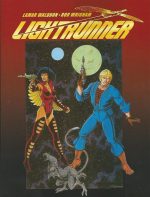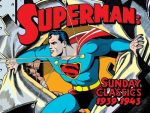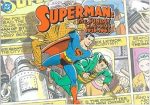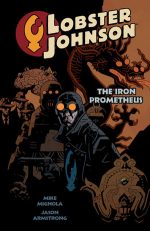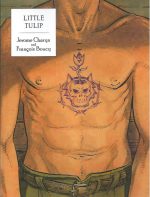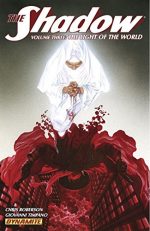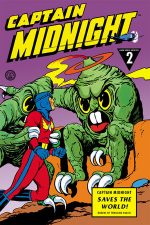
By William Woolfolk, Leonard Frank, Dan Barry & various (Dark Horse Comics)
ISBN: 978-1-61655-243-5Â Â Â Â Â Â Â Â Â Â Â Â Â Â Â Â Â eISBN: 978-1-62115-921-6
Created by broadcast scripters Wilfred G. Moore and Robert M. Burtt, Captain Midnight began as a star of radio serials in the days when troubleshooting All-American aviators were the acme of adventure genre heroes. The Captain Midnight Program soldiered on from 1938 to 1940 until the Wander Company acquired the sponsorship rights to promote their top product: Ovaltine. From there on, national radio syndication led to a newspaper comic strip (by Erwin L. Hess, running from June 29th 1942 until the end of the decade); a movie serial (1942) and – later – two TV serials (1953 and 1954-1956) before being overdubbed, retitled and syndicated as “Jet Jackson, Flying Commando†well into the 1960s). There was also a mountain of now-legendary merchandise such as the infamous Captain Midnight Secret Decoder Ring…
And there was a comicbook franchise… one recently reinvigorated for 21st century audiences.
The hero’s basic origin related how after the Great War ended, pilot and inventor Captain Jim Albright returned home having earned the sobriquet “Captain Midnight†following a particularly harrowing mission that concluded successfully at the witching hour.
He then formed a paramilitary “Secret Squadron†of like-minded pilots to continue making the world a better place – often at the covert behest of the President – using guts and gadgets to foil spies, catch crooks and defend the helpless.
Captain Midnight truly hit his stride after Japan’s sneak attack on Pearl Harbor, becoming an early Home Front media sensation throughout the war years. However, his already fluid backstory and appearance underwent a radical makeover when he switched comicbook horses in midstream.
This stunningly engaging full-colour paperback collection (also available as an eBook) gathers a slew of science fiction-themed tales taken from the latter end of the Fawcett Comics run. Captain Midnight #48, 50, 52-56, 58, 60, 62, 64 and 66 spanned February 1947 – August 1948 and with times and tastes changing the venerable title folded with the next issue…
Following a fervent Introduction from Batton Lash discussing the career of the much-travelled, constantly evolving “Monarch of the Airways†and the telling differences between the radio, screen and comicbook iterations, the contents explosively unfold with a tragic dearth of credit and attributions. Much comic material from this era is criminally unattributed but regular writers known to be active on Midnight at this juncture included Bill Woolfolk and Otto Binder whilst artists included the unflagging Leonard Frank and young legends-to-be Leonard Starr and Dan Barry.
From issue #48 ‘Captain Midnight Visits the Golden Asteroid’ sees Albright and his mechanic Ichabod Mudd piloting their newly invented rocket-ship to investigate a new stellar body only to find that the astronomer who discovered it has an ulterior and nefarious motive for getting to the stellar wanderer.
Illustrated by Frank and from #50, ‘Captain Midnight Spikes the Sun Gun’ pitted the modern Edison against devilish Dr. Pyrrho who had found a way to inflict destructive heat on the already sweltering citizens of the American Southwest after which a return prospecting trip to our nearest neighbour uncovered ‘The Moon Creatures’ (Woolfolk) who aggressively resisted all attempts to colonise Luna…
With the solar system now a regular destination for exploration, Albright began an occasional series of sorties to the planets and picked up some new recurring foes. The first was a plundering barbarian from Pluto who raided Earth for its Uranium reserves in #52’s ‘Captain Midnight versus the Space Raider!’ (Binder & Frank).
The resultant chase and recovery took our hero to Mars and first contact with an unsuspected race also under threat of merciless assault by the murderous Jagga…
After driving the fiend off and recovering his ill-gotten gains, Midnight next encountered the ruthless Plutonian inflicting ‘Peril on Venus’ in #53. By sending him packing once again, the inventor consequently aided the long-lost last survivors of Atlantis in getting their failing colony onto an even keel in a world overrun by dinosaurs…
In #54 Midnight and Icky encountered yet another embattled civilisation on Ceres: a literally golden kingdom fending off Jagga’s bacterial onslaught and meteoroid bombardments. With the Air Aces’ assistance, the monster was finally driven off in ‘The Asteroid Battle’…
There’s a double dose of super-scientific spectacle in #55, beginning with Albright’s perhaps unwise invention of a monumental dirigible intended as ‘The Sky Airport’. When common thugs steal the mobile monolith and use it as a base for air raids on banks, the heartbroken genius is forced into desperate action to clear his conscience…
This is followed by another interplanetary incident when ‘Captain Midnight Finds the Lunar Lair’ and finally brings Jagga to justice in the form of a trial in Earth’s courts. Unequivocally guilty, the beast is sentenced to death by electrocution in #56’s ‘The Last Rites of Jagga’ (Frank art) but said execution proves to be a major mistake and Midnight is called upon to deliver the sentence in his own infallible scientific manner…
A new alien threat emerges in #58 ‘On the Planet of Peril’ when an unknown race reanimates Earth’s greatest villains and monsters…
A month later ‘Captain Midnight Battles the Ice Age’ found our interplanetary explorers on Neptune: changing that world’ climate to give its humanoid inhabitants a big step up the ladder to civilisation, whilst issue #60 saw the return of earthly arch-enemy Dr. Osmosis who terrified and tormented humanity with his explosive ‘Flying Saucers of Death’…
Captain Midnight #62 detailed the inventor’s efforts to save America’s ‘Farmers on the Moon’ from sabotage as Earth agricultural entrepreneur Jim Klaw sought to maintain his produce monopoly at all costs…
A new extraterrestrial enemy debuted in #64 as ‘Beyond the Sun’ (Frank) introduced shapeshifting tyrant Xog: a gaseous monster from Saturn who boarded America’s newest spaceships as step one in his plans for interplanetary domination. When Captain Midnight thwarted the scheme and rescued the hostage Terrans, the vile king swore vengeance…
It came in the final tale in this superbly retro rollercoaster of rocket-powered fun – from #66 with art by Frank – as Xog transforms Captain Midnight into sentient gas before invading Earth. Happily, even ‘Without a Body’ Albright was too much for the malign marauder and once more saved the day and the world…
With a stunning gallery of covers by Frank, Charles Tomsey, Dan Barry and Mac Raboy plus cool mini-features such as ‘Captain Midnight’s Air Lingo’, ‘US Army Aviation Badge Insignia’ and ‘Famous Planes’, this fabulous feast of fantasy is guaranteed to satisfy the nostalgic yearnings of every starry-eyed space cadet, whatever their age.
Captain Midnight Archives volume 2: Captain Midnight Saves the World! ® and ©Dark Horse Comics 2014. All rights reserved.




